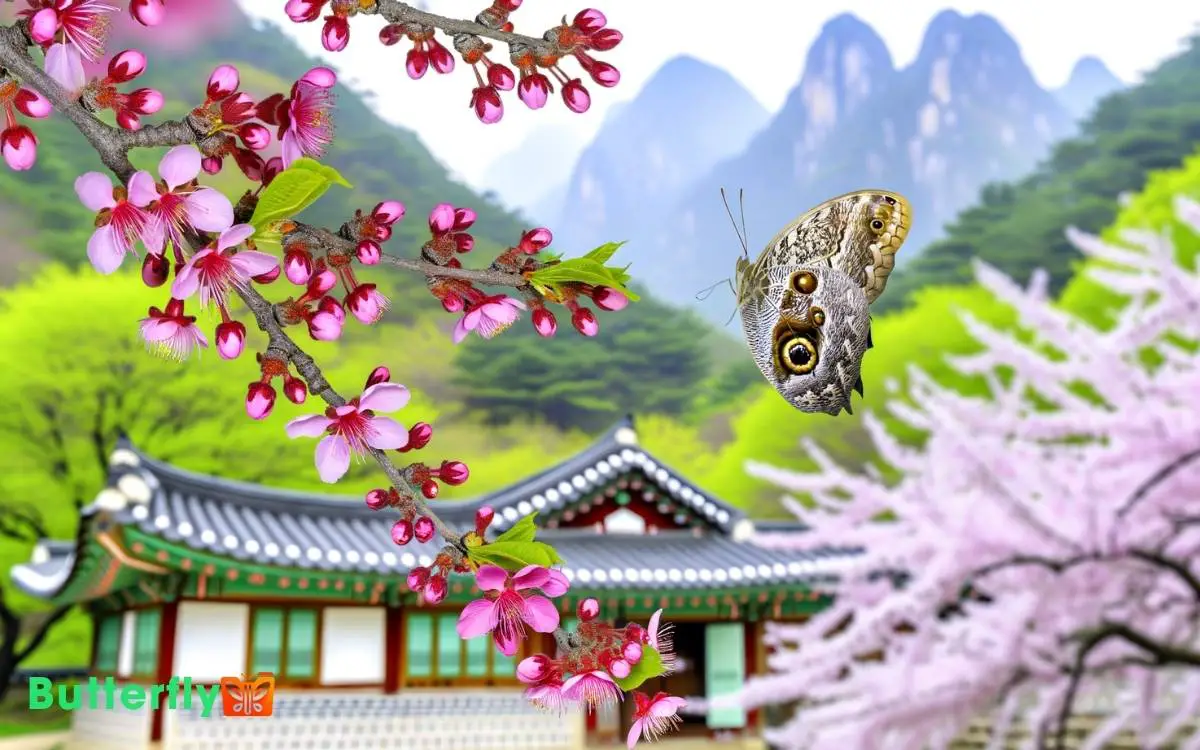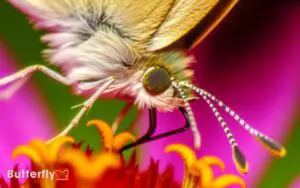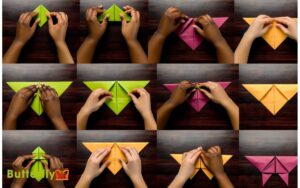How Do You Say Butterfly In Korean? 나비’ (nabi)!
In Korean, you say butterfly as ‘나비’ (nabi). This term consists of two syllables: ‘na’ and ‘bi’, each with its own phonetic and cultural significance.
To pronounce it correctly, use a soft nasal ‘n’ and an open front vowel ‘a’ for ‘na’, and a voiced bilabial stop ‘b’ with a high front vowel ‘i’ for ‘bi’. Butterflies in Korean culture symbolize transformation, joy, and the transient nature of life.
Their presence in art and folklore underscores their societal importance. By exploring the nuances of ‘nabi’, you’ll deepen your understanding of the Korean language.

Key Takeaways
The Korean Word for Butterfly
In Korean, the word for butterfly is ‘나비’ (nabi). When you analyze this term, you’ll find that it’s composed of two syllables: ‘na’ and ‘bi’. Each syllable carries its own significance in the Korean language, contributing to the term’s overall meaning and phonetic structure. Similarly, in other languages, the word for butterfly carries unique phonetic and cultural significance. For example, the word for butterfly in Spanish is ‘mariposa,’ which has a distinct rhythm and elegance when spoken. This comparison highlights how different languages encapsulate the beauty of nature through their own linguistic structures.
Understanding these components helps you grasp the linguistic nuances that make Korean distinct.
Additionally, recognizing the structure and etymology of ‘나비’ (nabi) allows you to appreciate the elegance of the language. It’s not just about memorizing words but about understanding their roots and connections.
This depth of comprehension provides a more holistic approach to language learning, fostering innovation in your linguistic endeavors.
Pronunciation Guide
Mastering the pronunciation of ‘나비’ (nabi) involves understanding the subtleties of each syllable’s sound.
- First, focus on ‘na’ (나). The ‘n’ is pronounced as a soft nasal consonant, similar to the English ‘n.’ The ‘a’ is an open front vowel, akin to the ‘a’ in ‘father.’
- Next, consider ‘bi’ (비). The ‘b’ is a voiced bilabial stop, much like the English ‘b,’ but slightly softer. The ‘i’ is a high front vowel, similar to the ‘ee’ in ‘see.’
- Pay close attention to the connection between syllables, ensuring a smooth and fluid link. Consistent practice will refine your pronunciation, making your articulation both accurate and natural.
This meticulous approach guarantees you grasp the nuances of Korean phonetics.
Butterfly in Korean Culture
Butterflies hold significant symbolic meaning in Korean culture, often representing transformation, joy, and the ephemeral nature of life.
You’ll find butterflies in Korean art and literature, where they signify not just beauty, but also the transient nature of happiness and human existence.
The butterfly’s metamorphosis from caterpillar to its final, delicate form embodies personal growth and spiritual evolution.
In traditional Korean folklore, butterflies are believed to carry the souls of the deceased, serving as messengers between worlds.
This dual symbolism of life’s fleeting joys and profound spiritual transformation—resonates deeply within Korean societal values.
Learning Through Examples
Frequently, understanding the Korean word for ‘butterfly’ becomes easier when you examine its usage in various contexts and sentences. By analyzing examples, you can grasp nuances and syntactic patterns.
Consider the table below, which demonstrates how ‘나비’ (nabi) integrates into different sentences:
| Korean Sentence | Romanization | English Translation |
|---|---|---|
| 나비가 날아다닌다. | Nabi-ga nar-adaninda. | The butterfly is flying. |
| 나비는 아름답다. | Nabi-neun areumdapda. | The butterfly is beautiful. |
| 아이가 나비를 잡았다. | Ai-ga nabi-reul jabatda. | The child caught a butterfly. |
| 나비가 꽃에 앉았다. | Nabi-ga kkot-e anjatda. | The butterfly landed on a flower. |
| 나비처럼 자유롭다. | Nabi-cheoreom jayuropta. | Free like a butterfly. |
Analyzing these sentences helps you understand the contextual versatility of ‘나비’. This method enhances your linguistic intuition and fosters innovative language learning.
Common Phrases With Butterfly
Often, you’ll encounter the word ‘butterfly’ in various idiomatic expressions and phrases that enrich the Korean language. These phrases not only add color but also convey deeper meanings, reflecting cultural nuances and societal values.
Here are some common phrases with ‘butterfly’ (나비):
- 나비처럼 날다 – ‘Fly like a butterfly’: This phrase symbolizes grace and elegance in movement.
- 나비효과 – ‘Butterfly effect’: Borrowed from chaos theory, it signifies small actions leading to significant consequences.
- 나비처럼 가볍다 – ‘Light as a butterfly’: Used to describe something or someone very light or delicate.
- 나비 꿈 – ‘Butterfly dream’: Refers to a fleeting dream, inspired by Zhuangzi’s famous philosophical metaphor.
These expressions provide a nuanced understanding of Korean cultural idioms.
Tips for Remembering the Word
Having explored the rich idiomatic expressions involving the word ‘butterfly‘, you can now focus on effective strategies for remembering the Korean term 나비 (nabi).
One innovative approach is to create a mental association with the image of a butterfly (‘nabi’) when studying related vocabulary. Incorporate visual aids, such as flashcards with the word and a butterfly image.
Utilize spaced repetition techniques within language apps to reinforce memory over intervals. Additionally, integrating the word into daily conversation or journaling in Korean reinforces retention.
Conclusion
To sum it up, mastering the Korean word for butterfly, 나비 (nabi), enriches both your vocabulary and cultural understanding.
Embrace the pronunciation guide and cultural insights provided to deepen your learning experience.
Practice common phrases and use mnemonic techniques to solidify your memory.
Remember, Rome wasn’t built in a day; consistent practice is key.
Your journey through the intricacies of language and culture is just beginning, so keep exploring and expanding your horizons.






